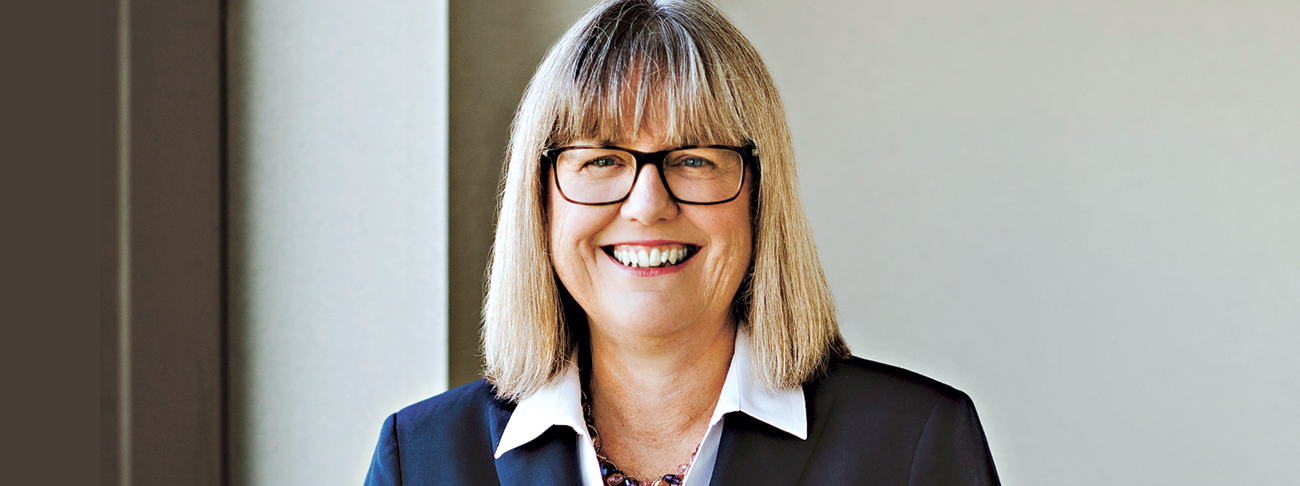
Donna Strickland is a physics professor at the University of Waterloo where her ultrafast laser group develops high-intensity laser systems for non-linear optics investigations. Last December, she and former colleague Gérard Mourou shared in the award of the Nobel Prize in Physics for development of chirped pulse amplification, or, as the Nobel site describes their accomplishment, “for their method of generating high-intensity, ultra-short optical pulses.”
Strickland and Mourou published their Nobel-winning research in 1985 when she was a PhD student at the University of Rochester. Their work has carved the way for the most intense laser pulses ever created, used to cut patients’ corneal flaps in laser eye surgery, and in creating small glass parts for use in cell phone technology.
As Strickland recalls of the research, “we wanted a pulse as long as possible in order to be able to amplify it. Ideally, we would have wanted a nanosecond, and if we’d used fibre it would have taken three to four kilometres, which we didn’t have. But we got 2.5 kilometres donated by Corning after Gérard begged them. We had no money for this project — so he begged them for a donation, and they sent us 2.5 kilometres.”
Strickland ended up accidentally breaking the fibre cable when she unspooled it. The larger piece was 1.4 kilometres, which they used. It ended up being sufficient for producing the results they sought.
After receiving news last October of her win, Strickland was at the centre of a whirlwind of activity, including the weeklong events in Stockholm leading up to the actual award of the Nobel medal and certificate on Dec. 10, an inundation of media interview requests, and her promotion to full professor at her university.
“It was a fantastic weeklong experience starting at the Nobel Museum where they explained the process and what would happen in the upcoming week. Gérard and I signed the same chair that had been signed by Alice Munro, the Canadian short-story writer who won in 2013 for literature — anyone who goes to the Nobel Museum and eats in the bistro can turn over a chair and see the signatures of Nobel Laureates.”
“Then I gave my Nobel lecture, which you must in order to get the prize, as laid out in Alfred Nobel’s will. It’s a lecture to the public so you have to be able to explain your science in a way that the public can understand,” Strickland says.
Of her overall experience, she recounts equal measure of delight, nerves and a positive impression of members of Sweden’s royal family, who attend some of the events throughout the week, including the award ceremony where Laureates meet Sweden’s King, Carl XVI Gustaf.
“The tenth was the big day. It started at 10:30 in the morning where you practice accepting the prize from the King. He was not there; they use a stand-in at the practice, of course. We also practised bowing three times, to each other, to the Swedish Academy, and then to the audience,” she recalls. “During the actual ceremony, the King was very good. Because it’s fairly heavy, both the medal and the certificate with a piece of artwork in it, you need four hands on it as it’s being awarded. The King slides the medal and the box under your thumb and makes sure you’ve really got hold of it, before we both let go to shake hands over top of it.”
But during her week in Europe Strickland observed a striking difference between treatment by the media of North American Laureates, and winners from other parts of the world.
She immediately noticed that the Nobel week events were televised in many countries in the world, including Sweden, but not in North America.
Strickland saw crowds of reporters following Tasuku Honjo, the Japanese researcher who jointly won the Nobel Prize in Physiology or Medicine with American scientist James Allison for their discovery of cancer therapy by inhibition of negative immune regulation.
“He couldn’t make a move without reporters following him closely,” Strickland said. “Everyone in Japan knows who he is and he has a rock-star status there.”
Strickland says she and Allison were largely ignored, due to the lack of North American media. She worries about the clear difference in how science is perceived between North Americans and other cultures — particularly Asian — and that the relative lack of interest feeds a public dearth of understanding of its importance.
“Asian countries think science is important. They revere it and put emphasis on funding and promoting interest in it,” she says. “I worry we need to adopt a stronger focus on science in North America, or we may find ourselves falling further and further behind countries like China.”